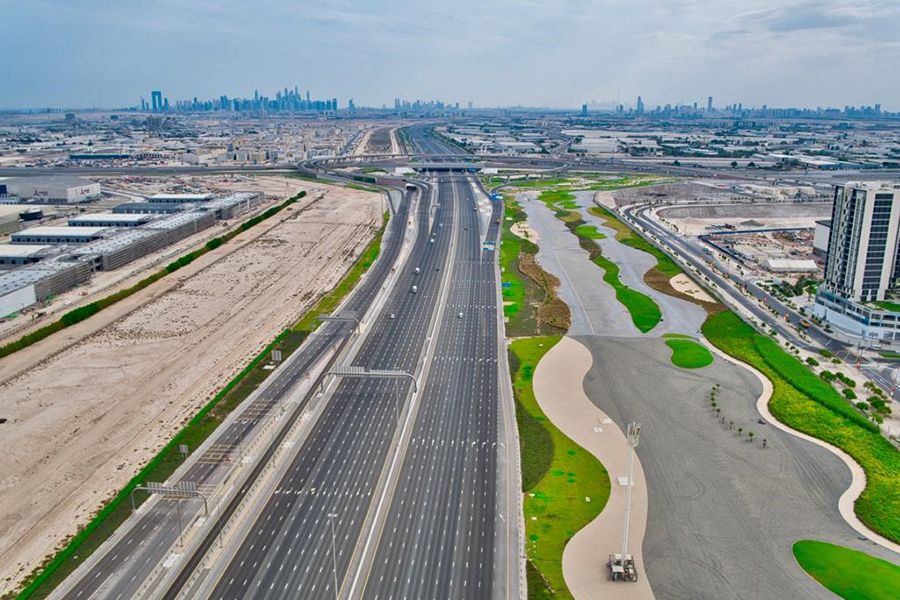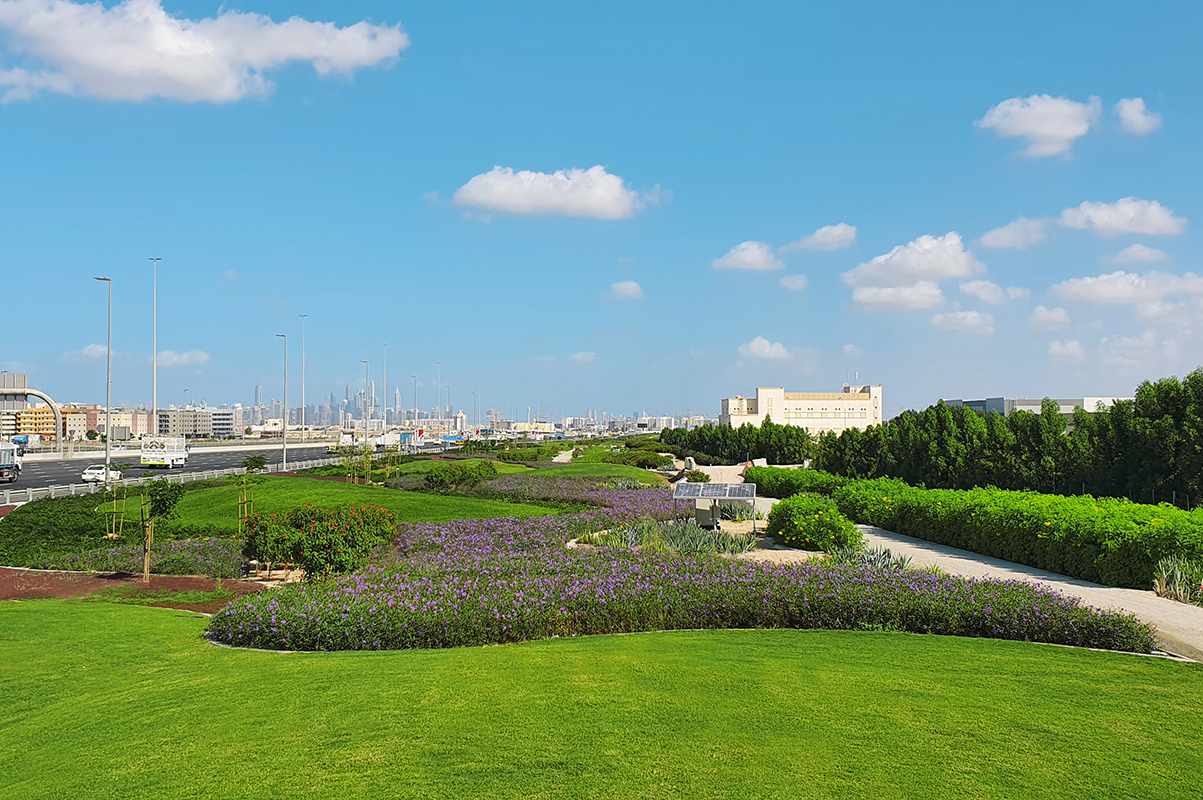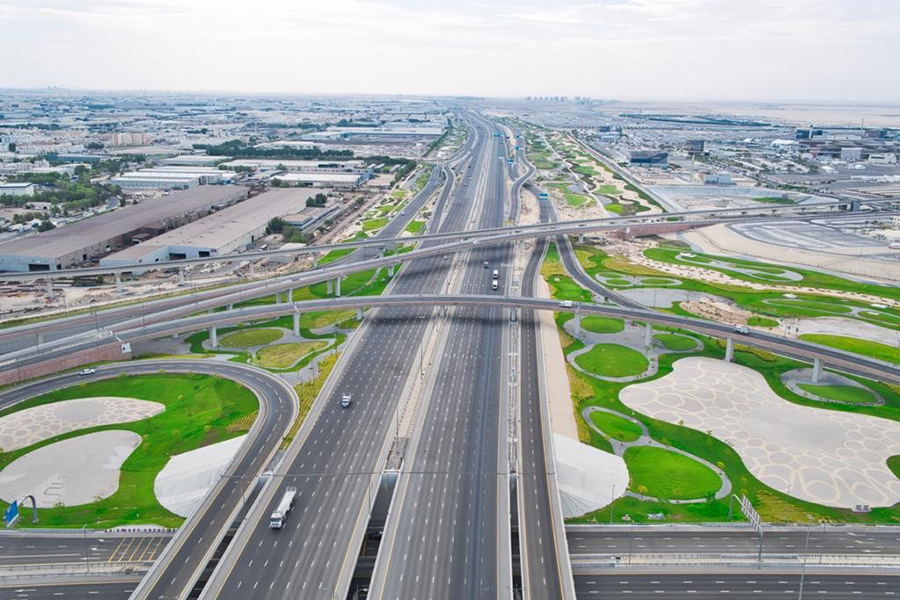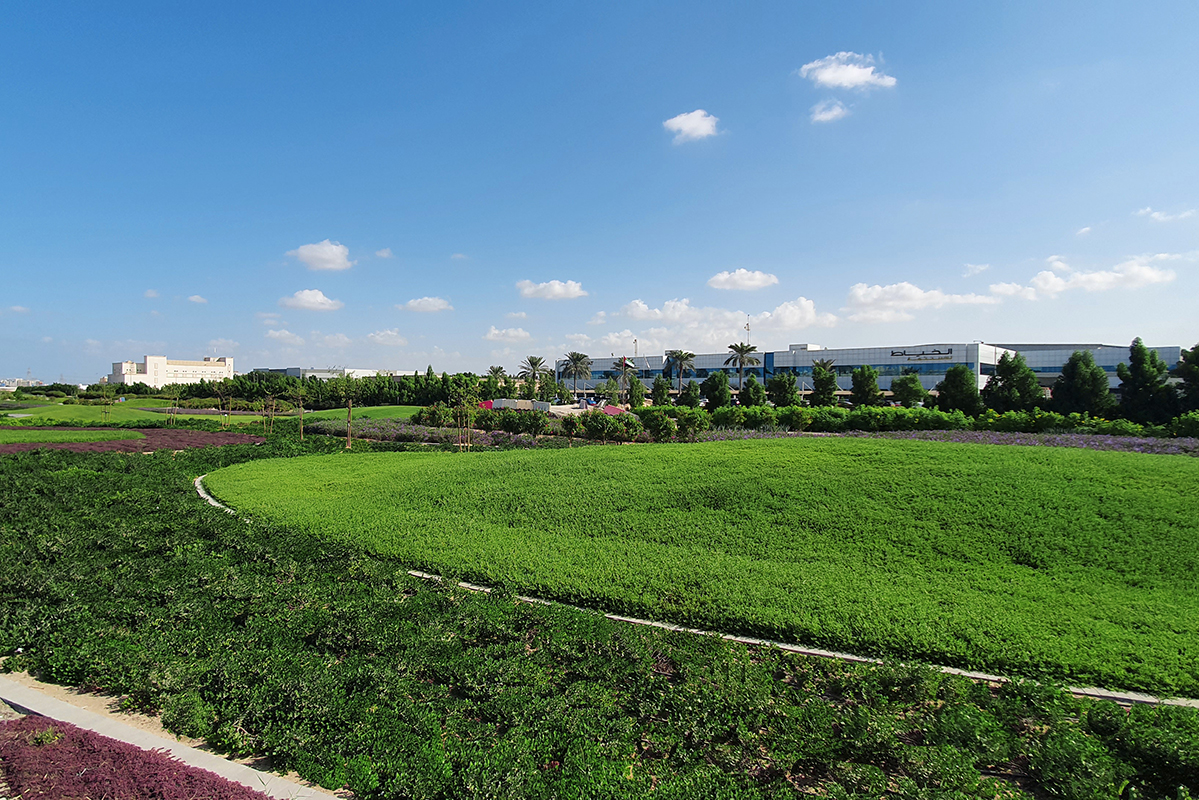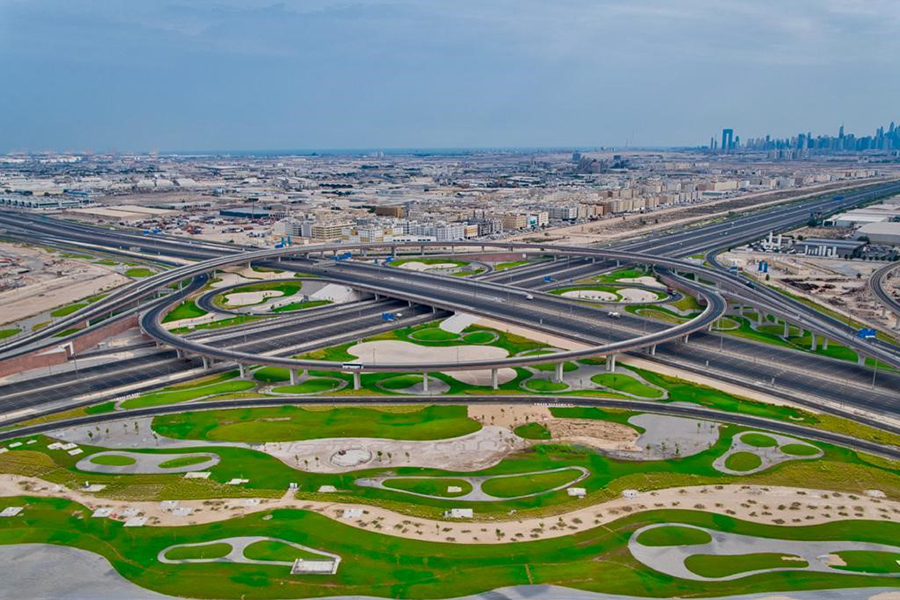Benefits of Urban Greening
Harnessing the Power of Plants
The Green Paths to Future initiative to plant roads leading to Expo 2020 in Dubai is underpinned by compelling scientific evidence that underscores the immense potential of plants and natural ecosystems to yield substantial benefits. This initiative aligns seamlessly with an avant-garde vision for the City, addressing contemporary challenges while fostering a sustainable, vibrant urban landscape.
Scientific research consistently underscores the advantages of urban greenery—improved air quality, ameliorated heat islands and heightened wellbeing. Research reveals that strategically placed vegetation can reduce urban temperatures by up to five degrees Celsius, mitigating the urban heat island effect and curbing energy consumption for cooling.
The Green Paths to Future initiative capitalises on these findings by integrating greenery along roads, combatting desertification, abating urban heat islands and alleviating air pollution prevalent in the industrial vicinity. This strategy, substantiated by empirical data, aligns harmoniously with Dubai’s future-focused ethos of sustainable urban development.
The innovative road planting not only addresses climate challenges but also enhances the experience of Expo 2020 visitors as well as the upcoming worldwide event COP28 scheduled for November 2023. Fusing nature with industry reflects Dubai’s resolve to unify modernity and sustainability. This initiative exemplifies Dubai’s commitment to creating a robust, habitable urban environment responsive to future needs. Rooted in scientific insights, it cultivates an innovative blueprint for urban development, prioritising ecological equilibrium, human wellbeing, and a progressive urban identity.
Delivering Multiple Benefits
The Green Paths to Future initiative harnesses the versatile potential of plants and interconnected ecosystems to yield diverse benefits. Through strategically planting roads to Expo 2020 in Dubai, we create a synergy of advantages that extend beyond single objectives. This initiative seamlessly integrates into local policies and planning mechanisms, backed by strong governance and political support.
The road planting serves a dual purpose—combating desertification and mitigating the urban heat island effect. Vegetation fights desert encroachment while tempering extreme urban temperatures. This approach aligns with global urban sustainability practices.
Our initiative aligns with local policy. It resonates with Dubai’s strategic focus on environmental sustainability and human wellbeing. It aligns with urban greening goals in the Dubai 2040 Urban Master Plan. It’s also in line with the UAE’s commitment to UN Sustainable Development Goals (SDGs), especially Goals 13 (Climate Action) and 15 (Life on Land).
Support is evident from governance and political realms. The Dubai Municipality has officially endorsed our project as a significant component of its proactive environmental initiatives, showcasing a dedicated commitment to sustainable progress. Government officials across various levels commend the initiative’s alignment with Dubai’s comprehensive sustainable urban development vision. This sentiment is echoed by local environmental agencies, which have wholeheartedly endorsed our initiative’s transformative potential in fostering ecological resilience and enhancing urban wellbeing.
In summary, our initiative harnesses plants and ecosystems for diverse benefits—addressing desertification and urban heat, aligning with policies and gaining strong governance support. It amalgamates ecology, policy and politics, reflecting its holistic essence and transformative capacity.
The City’s Bold and Innovative Vision
The initiative Green Paths to Future envisions a transformative urban landscape, merging environmental sustainability with smart technology. Uniquely addressing challenges posed by a high-water table, the initiative employs innovative techniques that revolutionise conventional urban development paradigms.
Our vision for Green Paths to Future entails creating lush corridors through urban areas, combating high water tables while enhancing aesthetics and water management. What sets us apart is the integration of smart irrigation systems, designed to optimise water usage. This bolsters efficiency while addressing water table concerns, showcasing our commitment to ecological equilibrium and technological advancement.
In addition to smart irrigation, the incorporation of water basins further distinguishes our initiative. These basins serve dual purposes—beautification and water collection. This innovation transforms urban spaces into serene oases while also mitigating water-related challenges.
Funding for Green Paths to Future is equally groundbreaking. We’ve pioneered a hybrid model, merging public and private funds (design and maintenance). This approach symbolises a collective commitment to sustainable urban progress.
The delivery process hinges on cross-disciplinary collaboration. Architects, water engineers, landscape designers, and technologists unite to ensure seamless execution, cementing our initiative’s comprehensive nature.
Our initiative redefines urban development. By skillfully integrating smart technology, ecological sensitivity, and multi-disciplinary collaboration, we present a novel way of addressing urban water challenges. Green Paths to Future demonstrates that innovation in technique, funding, and execution can harmonise nature, technology, and community for a more sustainable urban future.
Partnerships and Collaboration
The initiative thrives on collaborative synergy across disciplines and sectors, bolstering its efficacy and impact. Our approach hinges on engaging diverse stakeholders beyond the green space industry, exemplifying our commitment to holistic urban development.
Collaborations with various professionals, including highway engineers, water engineers, health experts, planners, architects, artists and sociologists, enrich our initiative. By weaving their expertise into the fabric of our project, we ensure a comprehensive, well-rounded strategy.
Highway engineers contribute insights on road integration, ensuring that green spaces align seamlessly with infrastructural needs. Water engineers offer solutions to optimise irrigation and water management, promoting sustainable resource use.
Health professionals play a pivotal role by validating the mental and physical wellbeing benefits of urban greenery. Their insights substantiate our initiative’s positive impact on public health, reinforcing its value proposition.
Planners, architects and artists bring creative visions, enhancing the aesthetic and functional aspects of our design. Their involvement ensures that our initiative is not just environmentally sound but also culturally resonant and visually appealing.
Sociologists offer insights into community dynamics, shaping strategies that foster local engagement and ownership. Their input cultivates a sense of belonging and collective responsibility among residents.
Collaborative working amplifies our initiative’s potential by integrating diverse perspectives, creating a multidimensional solution to urban challenges. It showcases the power of cross-disciplinary partnerships in redefining urban landscapes. Our project demonstrates that collaborative cohesion, spanning sectors and expertise, is vital for forging a sustainable, vibrant urban future.
Addressing Urban Challenges
The Issue
Dubai faces significant climate change and environmental challenges. The City’s rapid urbanisation and development have led to issues such as desertification, urban heat islands and high energy consumption. These problems are exacerbated by the harsh desert climate and challenging soil conditions.
Desertification is a major concern, as it leads to the loss of arable land and natural vegetation, contributing to soil erosion and decreased biodiversity. The proliferation of urban heat islands, areas with higher temperatures than their surroundings due to human activity, intensifies the already scorching temperatures, making the City less liveable and increasing energy consumption for cooling.
The combination of desertification and urban heat islands creates an adverse impact on the environment, quality of life and on the health of the population. The City’s mature and urban population is at greater risk of heat-related health issues, such as heatstroke and respiratory problems. Additionally, the energy-intensive cooling needs strain resources and contribute to greenhouse gas emissions, exacerbating climate change.
Addressing these issues is crucial not only for the wellbeing of the City’s residents but also to enhance the visitor experience during Expo 2020. By implementing projects like planting roads with greenery, the City aims to mitigate the impact of desertification and reduce the heat island effect. These efforts would help combat climate change, create more pleasant urban spaces, and improve air quality, making Dubai a more sustainable and enjoyable place for both residents and visitors.
The Impact of the Issue
Industrial areas in Dubai, exert significant influence on the local environment and neighbouring regions, including the Expo 2020 site. Their impacts encompass:
- Air Pollution: Industrial zones emit pollutants like particulate matter, sulphur dioxide and nitrogen oxides. These worsen air quality, leading to respiratory issues and contributing to smog and haze, compounding heat-related problems.
- Heat Emissions: Industrial processes release heat, elevating local temperatures. This exacerbates the urban heat island effect, heightening cooling demands and energy consumption.
- Greenhouse Gas Emissions: Industries are major greenhouse gas contributors, fuelling global climate change with far-reaching consequences on regional climates, weather patterns and sea levels.
- Water Use: Industries require substantial water for cooling and processing, straining water resources in arid regions like Dubai, resulting in water scarcity and environmental impacts.
- Land Use and Habitat Disruption: Industrial development transforms natural landscapes into built areas, disrupting ecosystems, diminishing biodiversity and contributing to soil degradation.
For Expo 2020 in Dubai, nearby industrial areas pose a significant concern due to emissions and pollutants that can affect air quality and climate conditions at the Expo site, potentially impacting visitors and residents.
A Nature Orientated Future
Expo 2020 addressed these challenges by planting over 24,000 trees, covering 2.3 million m2. These diverse trees, including ornamental and local species, provide shade, enhance the experience and act as natural air filters, improving air quality by removing pollutants. Importantly, in Dubai’s desert environment, this greenery combated soil erosion and reduced dust and sandstorms, fostering a more sustainable and pleasant environment for everyone involved.
Nature Positive Solutions
Implementation
The Green Paths to Future initiative in Dubai is a transformative infrastructure project spanning 16 km and 200 hectares, connecting the City to Expo 2020. It involved planting over 20,000 trees and four million seedlings along roadsides leading to Expo 2020, creating approximately 2.3 million square metres of developed green space, with an investment of 245 million dirhams during the construction phase from 2019 to 2020.
Over the past five years, the initiative has successfully achieved its objectives, significantly altering Dubai’s urban landscape. It has introduced extensive green areas, mitigated heat islands and improved air quality. By reducing humidity by 3%, lowering Particulate Matter 10 from 134 to 126, and decreasing Nitrogen Dioxide and Sulphur Dioxide levels, it addresses desertification and combats high temperatures through the addition of substantial greenery. While the temperature remained consistent, the project’s continuous development highlights substantial changes in the local climate and environment.
This initiative has not only beautified the City but also played a vital role in mitigating the impacts of climate change, aligning with Dubai’s broader sustainability goals. It successfully tackled topographical challenges and utility corridors by integrating Land art components into a cohesive green belt landscape. Overall, the Green Paths to Future initiative stands as a testament to its transformative impact on Dubai’s urban environment and its commitment to sustainability.
Feasibility
The feasibility of the Green Paths to Future initiative is substantiated by its ongoing financial and logistical support, ensuring both short-term and long-term goals are achievable. The initiative’s success has catalysed changes in planning and policy, with significant impacts on the broader economic landscape and urban development strategies in Dubai.
According to an EY report, Expo2020 Dubai and its anticipated legacy are set to contribute AED 154.9 billion ($42.2 billion) of gross value added (GVA) to the UAE’s economy from 2013 to 2042. The World Expo, which garnered 24.1 million visits during its six-month duration, is projected to support around 1,039,000 full-time equivalent (FTE) job years, equivalent to over 35,000 FTE jobs annually in the UAE over the same period.
The legacy of Expo 2020 Dubai is seen as a significant triumph, boosting the nation’s economy and enhancing the City’s international prominence. This success has had a far-reaching influence on Dubai’s urban planning and policies, shaping its approach to sustainable development and nature-based solutions. Notably, the achievement has also led to the attraction of globally significant events like the UN Climate Change Conference of Parties (COP28), scheduled to be hosted by the Expo City Dubai in November 2023.
In conclusion, the initiative’s feasibility is evidenced by its ongoing financial and logistical support and its transformative impact on Dubai’s economic prospects and urban development strategies. The initiative’s success has instigated changes in planning and policies, elevating Dubai’s profile on the global stage and reinforcing its commitment to sustainability and forward-thinking solutions.
Multi-Stakeholder Support
The Green Paths to Future initiative thrives on robust stakeholder support, exemplifying cross-disciplinary, multi-level, and multi-sectoral collaboration. Contributors from various sectors actively participate in its implementation, displaying comprehensive endorsement.
Key stakeholders include:
- Roads and Transport Authority (RTA): Integrating green pathways into transportation showcases RTA’s commitment to sustainable urban development, reflecting cross-disciplinary cooperation.
- Dubai Electricity and Water Authority (DEWA): Greenery along roadsides aligns with DEWA’s energy efficiency goals, highlighting cross-sectoral collaboration for improved air quality.
- Expo 2020 Dubai: Endorsing the initiative reflects multi-level support from a global platform, indicating a cross-disciplinary commitment to sustainable progress.
- Consultants and Contractors: Collaboration in design and execution signifies cross-disciplinary alignment for initiative realisation.
- Maintenance and Sewage Departments: Active participation reveals holistic cross-disciplinary engagement, from landscape preservation to underground networks.
Support extends to residents, businesses and professionals. Residents benefit from improved life quality, while businesses appreciate an attractive urban environment. Professionals contribute expertise, securing viability and underscoring cross-disciplinary nature.
In conclusion, the Green Paths to Future initiative embodies diverse collaboration, uniting governmental bodies, businesses, professionals and communities. This unity confirms its viability while emphasising Dubai’s commitment to nurturing a greener, sustainable cityscape through cross-disciplinary cooperation.
Management and Maintenance
The Green Paths to Future initiative prioritised efficient long-term management and maintenance through meticulous design and execution. This strategic approach is aimed at sustaining the initiative’s positive urban impact. Fundamental design principles included:
- Sustainable Landscaping: Native and drought-resistant plant species were selected, considering local climate conditions. This reduced water consumption and maintenance efforts.
- Modular Design: The project balanced softscape and hardscape elements, using adaptive, drought-tolerant plants in a 50:50 or 60:40 vegetation vs. complex elements ratio. Plantings were strategically placed for maximum visibility, improving air quality and sand control.
- Integrated Irrigation: Smart irrigation controllers and a wiring system were employed for precise water distribution, future expansion and reduced wastage. A functional rainwater channel was merged into a landscaped swale.
- Engagement of Maintenance Department: Collaborating with the maintenance department from the start enhanced long-term feasibility, while laybys facilitated easy upkeep and safety. Challenges were addressed proactively.
- Utility Corridors: Collaborative efforts with utility providers innovatively integrated functionality with aesthetics.
- Topographical Variability: Designer-engineer collaboration resulted in creative solutions for uniformity and terrain adaptation.
- Public Engagement: Community programmes fostered support and awareness. The initiative set a precedent for efficient management through smart tech, inter-departmental collaboration and community engagement. It ensured long-term sustainability and streamlined maintenance.
In conclusion, the Green Paths to Future initiative’s design and execution prioritise enduring efficiency. Sustainable landscaping, modular design, collaboration with departments, and managing challenges ensure a lasting positive urban impact.
Measuring and Reporting Impact
Monitoring Results
Our initiative aligns meticulously with Dubai Municipality’s KPIs for sustainability and urban living standards. These KPIs emphasise the importance of our innovative road landscaping projects in achieving sustainability goals and elevating the City’s overall quality of life. Through regular reports to the Dubai Municipality, we showcase quantifiable outcomes directly tied to our KPIs. For instance, our green space per capita, currently at 12.1, approaches our target of 15, showcasing our significant contribution to urban greenery.
Our initiatives have made remarkable progress in improving air quality. We’ve notably reduced pollutants like CO and benzene, leading to a healthier living environment. In 2019, CO levels averaged 0.374 mg/m³, while by 2023, they decreased to 0.439 mg/m³, aligning with the UAE’s allowable limit of 10 mg/m³ and international air quality standards. Benzene concentrations now measure only 0.37 ppb, well below the allowable limit of 0.72 ppb set by Ontario’s Ambient Air Quality Criteria. We actively engage with national agencies, supporting the UAE’s commitment to the UN SDG. Our initiative’s contributions to these global objectives are substantiated by data-driven reports that underscore outcomes intricately linked to our KPIs. Globally, our initiative positions Dubai as an innovative city dedicated to sustainability in the realm of sustainable urban development. Through the dissemination of methodologies, quantifiable outcomes, and success stories, we elevate Dubai’s international reputation as a leader in sustainable urban initiatives. Our rigorous monitoring protocols, including air quality tests and temperature measurements, are conducted through an approved Mobile Laboratory, ensuring reliable data for reporting.
Demonstrating Progress
Monitoring is the cornerstone of showcasing progress in our Green Paths to Future initiative, lending credence to our commitment to sustainable urban development. Through rigorous data collection, we substantiate the tangible impact achieved, thus enhancing our City’s credibility and appeal.
Measurable progress, derived from meticulous monitoring, serves as a compelling tool for attracting interest, funding and stakeholders. This empirical evidence substantiates our City’s greening ambitions, solidifying its reputation as a forward-thinking, eco-conscious urban centre. As metrics improve—such as air quality and increased green spaces—the City’s allure as a sustainable destination is amplified.
Furthermore, this data-driven approach empowers us to expand our greening efforts. Concrete results garnered through monitoring bolster our case when seeking funding for new projects and strategies, fostering the ongoing transformation of our urban landscape. One strategic avenue is enhancing the City’s irrigation network, which provides a foundation for developers to contribute to increased greenery.
By appealing to diverse stakeholders and presenting quantifiable outcomes, we create a virtuous cycle of attraction, funding and expansion. The integration of sustainable green spaces catalyses Dubai’s metamorphosis into an urban oasis, where environmental harmony intertwines with development aspirations. This approach showcases our commitment to a thriving, green future while enabling the City to stride confidently toward a more sustainable and vibrant horizon.
Measuring Impact
Our Green Paths to Future initiative has made a profound impact on Dubai’s urban landscape, using both quantitative metrics and qualitative narratives to measure and communicate progress effectively.
Quantitative Measurement: We’ve quantified our achievements with precise assessments of improved air quality. Pollutants like carbon monoxide and benzene have significantly reduced. Expansion of green spaces along roadways stands as a numeric testament to our initiative’s impact. Efforts to lower the high-water table have mitigated desertification’s effects on roads and enhanced environmental stability. Notably, benzene concentrations are now at just 0.37 ppb, far below the allowable limit of 0.72 ppb set by Ontario’s Ambient Air Quality Criteria, Ontario Ministry of the Environment. These findings underscore our commitment to better air quality, environmental resilience and community wellbeing.
Qualitative Measurement: We complement data with qualitative assessments, capturing stakeholder engagement, aesthetics and community wellbeing. These narratives reveal the initiative’s profound impact on residents’ lives and Dubai’s urban ambience.
Measurable Outcomes and Reporting: The initiative has delivered enriched greenery, improved air quality, moderated temperatures, and impressed Expo 2020 visitors. Reporting to Dubai Municipality, national agencies, and global platforms combines quantitative data with qualitative stories.
By combining quantifiable results with compelling narratives, our Green Paths to Future initiative demonstrates its transformative potential. It lays the groundwork for sustainable urban development, delivering diverse benefits from reduced desertification to enhanced aesthetics. Our initiative’s enduring impact aligns with Dubai’s role as a host of global events like the forthcoming COP28, reflecting a sustained commitment to a thriving urban environment.
Learning and Transferability
Adaption and Enhancement
The initiative has evolved significantly during its design and implementation, shaped by monitoring progress and valuable input from external stakeholders.
Design and Implementation Enhancements:
- Plant Diversity: Initially, a limited range of plant species were chosen for landscaping. However, continuous monitoring and research prompted us to diversify plant species, enhancing ecological resilience and air quality benefits.
- Irrigation Efficiency: We embraced advanced irrigation technologies like smart systems and soil moisture sensors to optimise water use and plant health, driven by insights gained through progress monitoring.
- Community Engagement: Responding to community feedback, we improved engagement efforts, organising workshops and community participation events to foster community ownership and pride.
Response to Progress Monitoring:
- Targeted Landscaping: Ongoing progress monitoring revealed areas with persistent high pollutant levels. We adapted landscaping strategies to concentrate efforts in these locations, maximising air purification benefits.
- Green Space Expansion: Monitoring progress toward the green space per capita KPI prompted us to identify additional sites for landscaping projects, strategically increasing greenery in underserved areas.
External Stakeholder Contributions:
- Community Engagement: Local communities played a vital role by providing feedback that influenced project timelines, ensuring minimal disruption during local events, and gaining community support.
- Expert Collaboration: Collaboration with environmental experts guided plant selection and ecological considerations, resulting in more effective and sustainable landscaping designs.
- Government Partnership: Close coordination with government agencies streamlined permitting processes, reducing project implementation timelines.
Potential for Replication
The Green Paths to Future initiative has generated a ripple effect beyond its initial scope, reshaping the City’s and its partners’ approach to working with plants and fostering knowledge transfer.
Transfer of Knowledge: By promoting knowledge transfer through Dubai Municipality customer service system, and collaborative projects, we’ve shared insights on plant selection, landscaping techniques and sustainability practices. This transfer of knowledge has empowered various stakeholders, including local communities, government agencies and landscaping professionals, to adopt eco-friendly approaches to urban greenery.
Changing the City’s Approach: Dubai’s municipal authorities have embraced a more holistic urban planning approach, recognising the significance of integrating green spaces into the urban fabric. The initiative’s success has inspired the City to incorporate similar nature-based solutions into its infrastructure projects, aligning with Dubai’s commitment to sustainability and climate resilience.
Influencing Partners: Landscaping and construction partners have adjusted their practices in response to the initiative’s sustainability goals. They now prioritise native and adaptive plant species and more efficient irrigation systems in their projects. This shift has fostered a culture of responsible landscaping across the City’s development sector.
Unexpected Changes: While the primary focus was on improving air quality, progress monitoring uncovered unexpected benefits. The increased greenery has effectively reduced the urban heat island effect, resulting in lower temperatures around project areas. This unanticipated change has improved overall urban comfort and public health.
The initiative transformed Dubai’s urban greenery approach, fostering knowledge sharing, influencing partners, and yielding unexpected urban climate improvements.
Inspiring Other Cities
Cities globally have expressed profound interest in the initiative due to its demonstrated success in enhancing air quality, urban aesthetics and mitigating the urban heat island effect. Its quantifiable achievements, particularly in reducing pollutants like CO and benzene, have attracted the attention of urban planners and policymakers worldwide. Representatives from various cities have visited Dubai to witness the initiative’s effects firsthand and engage in knowledge-sharing sessions, highlighting its international appeal.
The initiative’s strength lies in its adaptability. Its core principles, such as plant selection, efficient irrigation and community engagement, can be tailored to address the specific challenges and goals of other cities. Whether combating air pollution or mitigating extreme heat, the initiative’s flexible approach allows cities to customise it to their unique circumstances, fostering a sense of ownership and relevance.
Notably, the Al Ain Municipality landscaping team, a local partner, visited us in Dubai to acquire knowledge in advanced landscaping designs. Furthermore, we’ve extended our expertise to GCC countries, and have sought to benefit as well; for instance, we had the privilege of hosting Bahrain Municipality for similar knowledge-sharing endeavours. These collaborations underline the initiative’s regional significance and its role as a catalyst for sustainable urban development in the Gulf region.
The initiative has not only captured the attention of cities worldwide but has also become a hub for knowledge exchange within the GCC region. Its adaptability and proven success make it a powerful model for cities aiming to enhance their sustainability and improve the quality of life for their residents.
Resilience
Reducing Negative Impacts and Ensuring Sustainability
Efforts to reduce the carbon footprint of the Green Paths to Future initiative are integral to its alignment with Dubai’s sustainability goals. This initiative has strategically planted 2.3 million square metres of developed green space, playing a pivotal role in climate change mitigation.
Significantly increasing greenery, the initiative addresses climate challenges by mitigating the urban heat island effect, improving air quality and lowering humidity levels by 3% in 2022. Notably, it reduced Particulate Matter 10 levels from 134 to 126 in 2020 and curtailed nitrogen dioxide and sulphur dioxide levels. These achievements combat desertification and high temperatures, reducing the City’s carbon footprint.
Integrating a solar panel system in the irrigation network minimises carbon emissions, aligning with long-term sustainability. Additionally, sensor technology in the irrigation system reduces water demand, ensuring efficient usage and preserving this vital resource for future generations. Moreover, Native plants dominate the soft landscape, reducing the need for transportation from other countries. Moreover, locally sourced materials for grave areas minimise environmental impact.
In conclusion, the initiative is a remarkable example of urban transformation with a strong focus on reducing its carbon footprint. Through the strategic introduction of greenery, intelligent irrigation systems, sustainable practices and sensor technology, the initiative beautifies the City. It actively contributes to mitigating climate change and ensuring the long-term sustainability and resilience of positive outcomes. This initiative is a testament to Dubai’s commitment to a greener and more sustainable future, preserving resources for future generations.
Environmental Considerations
The initiative has proactively considered its anticipated environmental impacts throughout its planning and implementation. Plant selection is crucial, focusing on native and drought-resistant species suited to the local microclimate. This strategic choice reduces the need for extensive irrigation and ensures the long-term health of the planted greenery. Additionally, diversification in plant selection enhances biodiversity, fostering a resilient urban ecosystem and creating water collections in the design for migratory birds.
Efficient water management is another critical aspect. Rainwater harvesting systems have been integrated to collect and utilise rainwater effectively. This approach minimises reliance on potable water sources, reducing the environmental impact of water extraction. It is essential to mention that all drainage as sewage systems have been directly connected to tunnel projects to purify severe rainwater in Dubai for 100 years.
Energy efficiency is a priority as well. Solar panels are incorporated into the irrigation system, harnessing renewable energy and decreasing the carbon footprint associated with conventional power sources. Smart irrigation controllers enhance energy efficiency by optimising water distribution while minimising energy consumption.
Sustainable procurement practices are implemented to reduce waste generation and promote recycling. Local sourcing of materials for hardscape elements reduces transportation-related emissions. Robust recycling and waste management systems ensure responsible material disposal, minimising the environmental impact of construction and maintenance activities.
In conclusion, the initiative has adopted a comprehensive and environmentally conscious approach. Plant selection, water management, energy efficiency and sustainable procurement practices have all been carefully considered to anticipate and mitigate potential environmental impacts.
Use of Natural Resources
The Green Paths to Future initiative is deeply committed to the sustainable and considerate use of natural resources. It prioritises local soil sourcing, exclusively obtaining soil from Al Fujairah City in the UAE. This practice significantly reduces the need for long-distance soil transportation, minimising carbon emissions and preserving local ecosystems. Utilising native soils enhances the initiative’s sustainability while reducing its ecological footprint.
The initiative also incorporates rainwater harvesting systems, making rainwater the primary water source. This approach substantially reduces reliance on potable water, conserving this vital resource and aligning with responsible water management principles.
Regarding plant selection, the initiative focuses on drought-resistant and native species well-suited to the local microclimate. The initiative minimises water consumption and ensures efficient resource use by choosing species with lower water requirements.
Innovative irrigation technology further enhances resource efficiency by optimising water distribution reducing energy-intensive water sources’ reliance. Additionally, using organic fertilisers from Dubai Municipality Nursery promotes soil health and minimises environmental impact.
Sustainable landscaping practices promoting healthy soil and efficient water use are integral to the initiative. By creating low-maintenance landscapes, the initiative ensures long-term sustainability and resilience.
In summary, the Green Paths to Future initiative’s approach to natural resource utilisation is characterised by local soil sourcing, rainwater harvesting, drought-resistant plant selection, smart irrigation and organic fertilisers. These practices minimise environmental impact and enhance resource efficiency, aligning with Dubai’s commitment to responsible resource management and sustainability.


















